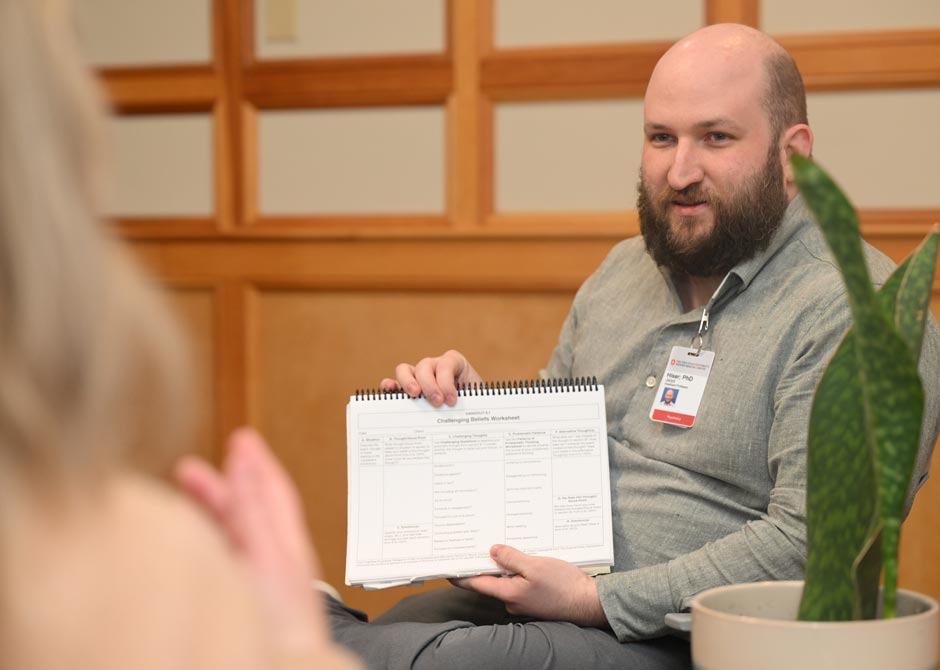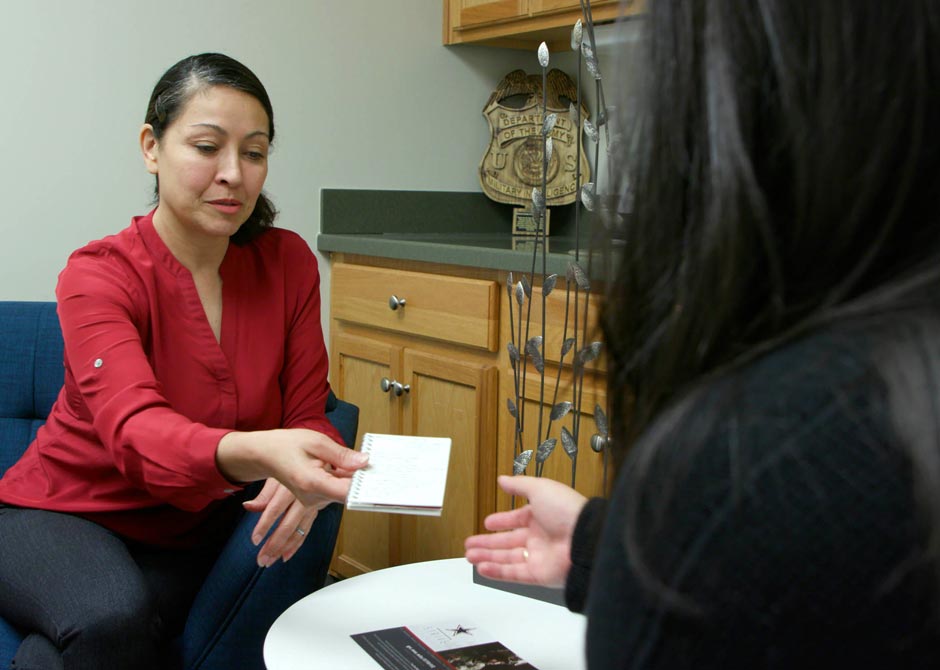 Most people will experience some type of trauma in their lives. Emotions such fear, anxiety and feeling overwhelmed are common and normal responses immediately following a traumatic event.
Most people will experience some type of trauma in their lives. Emotions such fear, anxiety and feeling overwhelmed are common and normal responses immediately following a traumatic event.
While these feelings will subside in a few weeks or months for many, sometimes they can last much longer and impact your relationships and ability to function. Sometimes a response to a traumatic event can turn into a mental health condition called post-traumatic stress disorder (PTSD).
Trauma can affect all aspects of your life, but it’s important to remember you don’t have to live with these symptoms forever and treatment can be very effective. The Ohio State University Wexner Medical Center is a national leader in researching trauma and PTSD and providing treatments in a culturally sensitive manner. We have evidence-based programs, such as Suicide and Trauma Reduction Initiative (STRIVE) and the Stress, Trauma And Resilience (STAR) program, that provide specialized treatment for a variety of people including veterans, sexual assault survivors and first responders.
What is trauma?
Trauma is an emotional response triggered by a distressing or traumatic event that you either experienced or witnessed. Examples of a traumatic event include military combat, verbal or sexual abuse, violence, natural disaster or severe injury, but it can be any experience that leaves you feeling overwhelmed or isolated.
After a traumatic event, you may have trouble coping but over time and with proper self-care, most people will begin to feel better. For others, it’s difficult to move through the traumatic memories, and they go on to develop symptoms of PTSD.
What is PTSD?
Post-traumatic stress disorder (PTSD) is a mental health disorder that can occur after living through or seeing a traumatic event. It’s the condition that develops when trauma symptoms don’t dissipate after a few months, and you continue to have nightmares, flashbacks or other issues.
PTSD can make you feel stressed, afraid, shameful or full of regret months later, impacting multiple aspects of your life, including your physical health. It’s a very specific type of mental health condition that leaves people feeling hopeless, guilty or even angry. The good news is there are effective therapies available that can ease, or even cure, PTSD symptoms.
Types of Trauma-Related Conditions
- Acute stress disorder – Acute stress disorder is commonly experienced in the month immediately after a traumatic event. If left unaddressed or untreated, acute stress disorder can eventually develop into PTSD.
- PTSD – PTSD can be caused by one specific traumatic event or multiple traumatic events over time.
PTSD can also occur alongside other mental health conditions, such as depression, anxiety, substance use disorder or suicidal thoughts. It’s important to distinguish PTSD from these other disorders and get an accurate diagnosis to identify the treatment approach that will be most beneficial to your unique situation.
Risk factors for PTSD
Not everyone who experiences trauma will develop PTSD. There are certain risk factors that may put someone at an increased risk of their symptoms being diagnosed as PTSD. Recognizing and addressing these risk factors can help prevent PTSD in some cases.
PTSD risk factors include:
- Experiencing a traumatic event
- Lack of family or social support
- Diagnosis of another mental health condition, such as depression or anxiety
- Family history of mental health conditions
- History of childhood trauma
- History of borderline personality disorder, paranoia, dependency or antisocial tendencies
It’s important to remember that just because you have these risk factors doesn’t mean you’ll develop PTSD. And likewise, if you don’t have these risk factors, you can still develop PTSD after a traumatic event.
 PTSD symptoms
PTSD symptoms
PTSD symptoms vary from person to person, and they may occur immediately after an event or much later.
Signs of PTSD often fall into one of four categories: intrusion, avoidance, negativity and arousal.
Intrusion symptoms
- Recurrent, unwanted and distressing memories about the traumatic event
- Nightmares
- Vivid flashbacks
- Distress from an internal or external reminder of the trauma
Avoidance symptoms
- Avoiding talking about what happened
- Avoiding people, places or activities that might remind you of the event
- Avoiding thinking about your trauma
Negative mood symptoms
- Feelings of fear or anxiety
- Shame or regret that takes over your life
- Dissociating with family, friends or activities that once brought you joy
- Memory loss
- Blaming yourself for the event
- Ongoing negative mood or being unable to experience positive emotions
Arousal symptoms
- Irritability and having angry or aggressive outbursts
- Difficulty falling or staying sleeping
- Having difficulty concentrating
- Impulsiveness or destructive behavior
- Being easily startled
- Feeling tense, on guard or on edge
How is PTSD diagnosed?
For a PTSD diagnosis, you’ll need to see a clinician with special training in the condition. Your mental health provider will use a diagnostic clinical intake and assessment measures to make a potential diagnosis.
Some information that will help inform the diagnosis include the following:
- A list of your current symptoms
- Relevant medical history
- Mental health history, including a psychological evaluation
- Presence of a qualifying traumatic event
Typically, your symptoms will meet certain criteria, as established by the American Psychological Association’s Diagnostic and Statistical Manual of Mental Disorders (DSM-5), to be considered PTSD. You must have experienced the following symptoms for at least one month:
- One intrusion symptom
- One avoidance symptom
- Two negative mood symptoms
- Two arousal symptoms
Approach to PTSD treatment at Ohio State
As leaders in diagnosing and treating PTSD, we champion the idea that there is hope and you can get better.
PTSD research has come a long way in a short amount of time, and there are now several very effective treatment methods. First-line treatments include psychotherapy interventions that target PTSD specifically.
Psychotherapy for PTSD
Evidence-based therapies for PTSD can be offered individually or in a group setting. We also provide many of these services via telehealth.
The psychotherapies that research shows as most effective in treating PTSD symptoms include:
- Cognitive Processing Therapy (CPT) – A type of cognitive behavioral therapy, this treatment is typically delivered over 10-12 appointments and helps you learn how to challenge and modify unhelpful beliefs related to trauma. In doing that, you’ll create a new understanding of the traumatic event, so it reduces its negative effects on current life.
- Prolonged Exposure Therapy (PE) – Another type of cognitive behavioral therapy, this treatment is also typically delivered over 10-12 appointments and consists of repeatedly telling the story of a disturbing traumatic memory followed by processing your thoughts and feelings about the story. The therapy also involves in-vivo exposure, which teaches you how to resume going to places that you’ve been avoiding because of the trauma, learning about PTSD and training in controlled breathing.
Multiple research studies show that over 80% of people who receive and complete one of these psychotherapies report significant improvement in their symptoms and over half no longer have the diagnosis of PTSD.
Medications for PTSD
Medications, such as antidepressants, can also be helpful in treating your PTSD symptoms.
Ohio State programs for PTSD
The Ohio State Wexner Medical Center is a national leader in treating PTSD and researching innovative and effective therapies. While many of our psychiatrists, psychologists, licensed clinical social workers and other mental health professionals across the medical center can treat your PTSD, we are also home to some dedicated programs that work with people with unique situations. These programs include:
Suicide and Trauma Reduction Initiative (STRIVE)
Initially established to help military personnel and veterans dealing with PTSD or suicidal thoughts, this internationally recognized program provides treatment to adults from all backgrounds who are dealing with these mental health conditions. STRIVE researchers and clinicians have pioneered methods to improve treatment outcomes for people with PTSD and suicidal thoughts, with over 70% of people receiving treatment from STRIVE reporting significant reductions in symptoms and improvements in quality of life. STRIVE’s success comes from its view of PTSD as an injury rather than a chronic disorder.
Stress, Trauma And Resilience (STAR)
STAR is a dedicated team whose sole purpose is the identification, education and treatment of those who have survived crime and the people who support them. STAR provides support services for first responders, health care workers and victims of violence.
